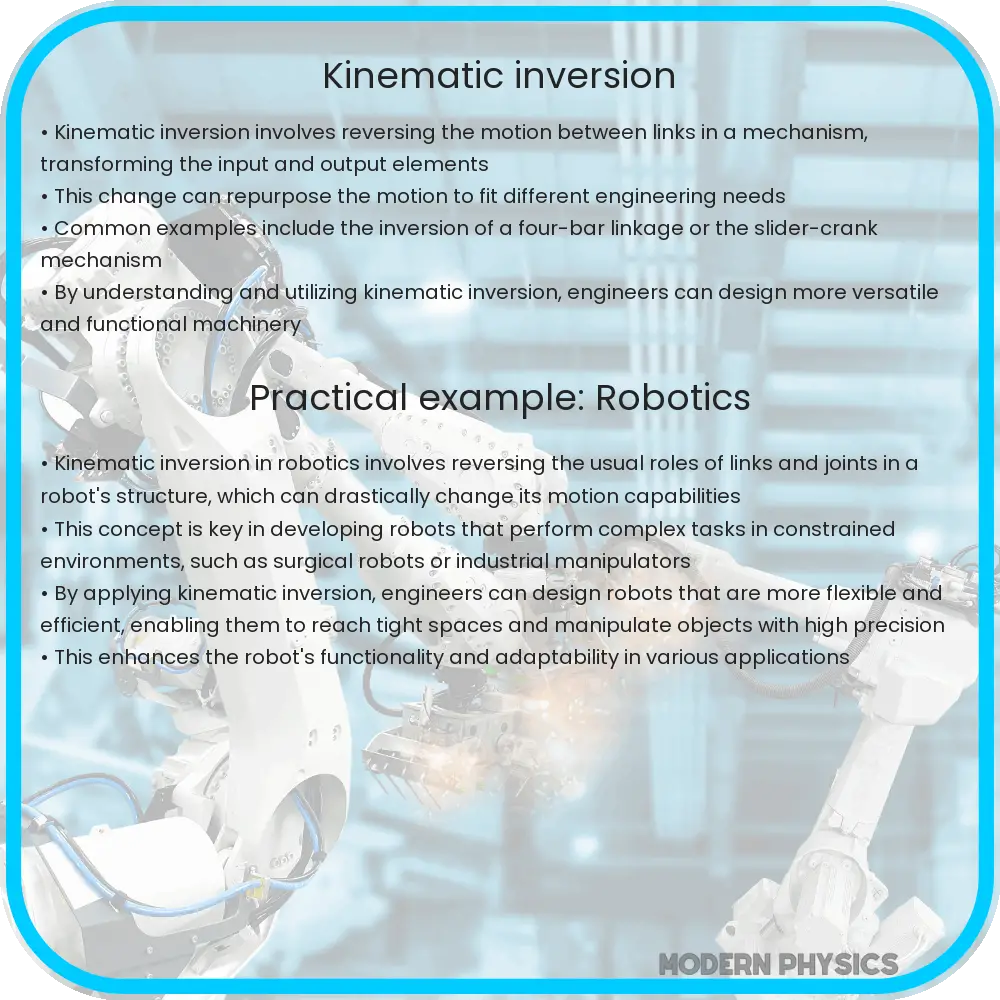Explore the essentials of kinematic inversion in mechanics, covering theoretical aspects, real-world applications, challenges, and future prospects.

Kinematic Inversion in Mechanics and Motion Analysis
Kinematic inversion is a fundamental concept in the field of mechanics, particularly relevant to motion analysis and mechanical design. It involves the study of the relative motion of interconnected parts, considering different reference points. This technique plays a vital role in understanding and designing mechanisms like gears, levers, and linkages, where the motion of one part dictates the movement of others.
Understanding Kinematic Chains and Inversions
A kinematic chain is a series of interconnected links and joints that create a system capable of motion. When one link of the chain is fixed, the movement of the other links is guided relative to the fixed link. Kinematic inversion occurs when a different link in the chain is fixed, leading to a change in the motion characteristics of the mechanism without altering its physical structure. This approach is essential in designing versatile machinery where different operations can be achieved by fixing different links.
Applications of Kinematic Inversion
Kinematic inversion finds its application in various fields, including robotics, automotive design, and manufacturing. For example, in a four-bar linkage system, fixing different links can lead to the creation of a crank-rocker mechanism, a double-crank mechanism, or a double-rocker mechanism, each having distinct motion characteristics useful for specific applications.
- Automotive Steering Systems: In vehicles, the steering mechanism is a classic example of kinematic inversion, where the relative motion of the steering linkages ensures smooth and responsive steering control.
- Robotics: Robotic arms often utilize kinematic inversion principles to achieve precise and varied movements, essential for tasks like assembly, welding, and painting.
- Manufacturing Equipment: In manufacturing, mechanisms like presses and feeders often use kinematic inversion to achieve different motion outputs, enhancing versatility and efficiency.
Motion Analysis through Kinematic Inversion
Understanding the motion of different mechanisms through kinematic inversion aids in the analysis and design of mechanical systems. By studying the velocities, accelerations, and forces within a system, engineers can optimize the design for efficiency, safety, and functionality. Kinematic inversion, therefore, not only assists in the conceptual phase of design but also plays a crucial role in the practical application and improvement of mechanical systems.
Kinematic inversion’s relevance in modern engineering cannot be overstated, given its implications in the design and functionality of a wide range of mechanical systems. The next section will delve deeper into specific examples and the theoretical aspects of kinematic inversion, providing a more comprehensive understanding of its impact on mechanics and motion analysis.
Theoretical Aspects of Kinematic Inversion
In the realm of kinematic inversion, the theoretical aspects revolve around understanding the motion trajectories, velocity, and acceleration of various components in a mechanism. This is achieved through mathematical models and graphical methods. For instance, in a slider-crank mechanism, the position of the slider can be determined at any point by applying the principles of kinematic inversion and understanding the constraints imposed by the other components of the system.
Case Studies: Kinematic Inversion in Practice
Real-world applications offer insightful case studies into the practical application of kinematic inversion. A notable example is the transformation of a single slider-crank mechanism into an oscillating cylinder engine. By fixing the crank instead of the frame, the same mechanism is inverted to serve a completely different function. Another example is in folding mechanisms found in furniture and machinery, where kinematic inversion allows for compact storage and efficient use of space.
Challenges and Innovations
While kinematic inversion provides a robust framework for understanding and designing mechanical systems, it also presents challenges. Ensuring smooth motion, minimizing wear and tear, and optimizing for energy efficiency are ongoing challenges in mechanical design. Recent innovations, such as the incorporation of computer-aided design (CAD) and simulation, have greatly enhanced the ability to predict and analyze the behavior of kinematically inverted systems, leading to more sophisticated and reliable designs.
Future Prospects
The future of kinematic inversion in mechanics and motion analysis is promising. With advancements in technology, especially in robotics and automation, the principles of kinematic inversion are being applied to more complex and dynamic systems. The integration of artificial intelligence and machine learning algorithms offers the potential for automated design and optimization of mechanical systems, further expanding the possibilities of kinematic inversion.
Conclusion
Kinematic inversion stands as a cornerstone in the field of mechanics, offering a versatile tool for understanding and designing a wide array of mechanical systems. From simple linkages in machinery to complex robotic systems, the principles of kinematic inversion continue to drive innovation and efficiency. As technology evolves, the scope and application of kinematic inversion are bound to expand, leading to more sophisticated and efficient mechanical systems. Embracing these principles is essential for any aspiring engineer or designer looking to make a mark in the field of mechanics and motion analysis.
